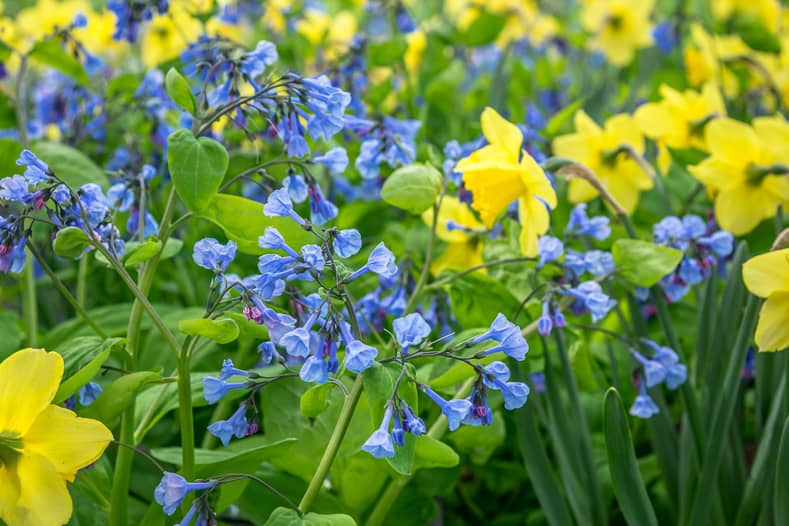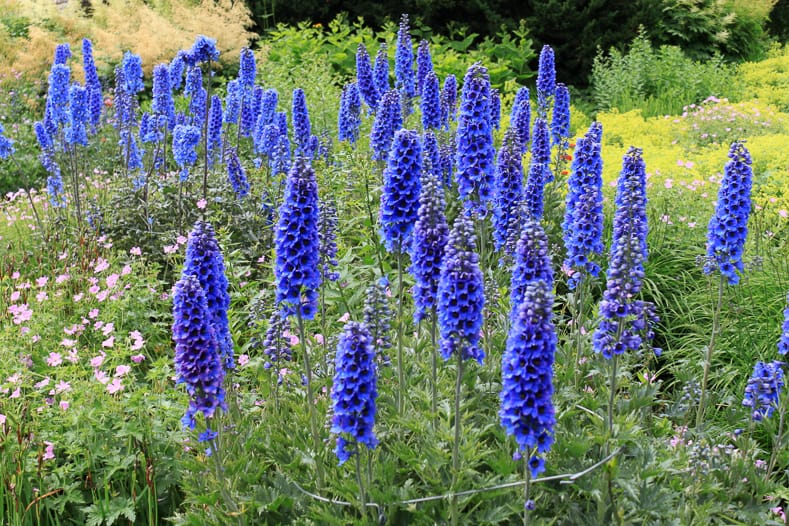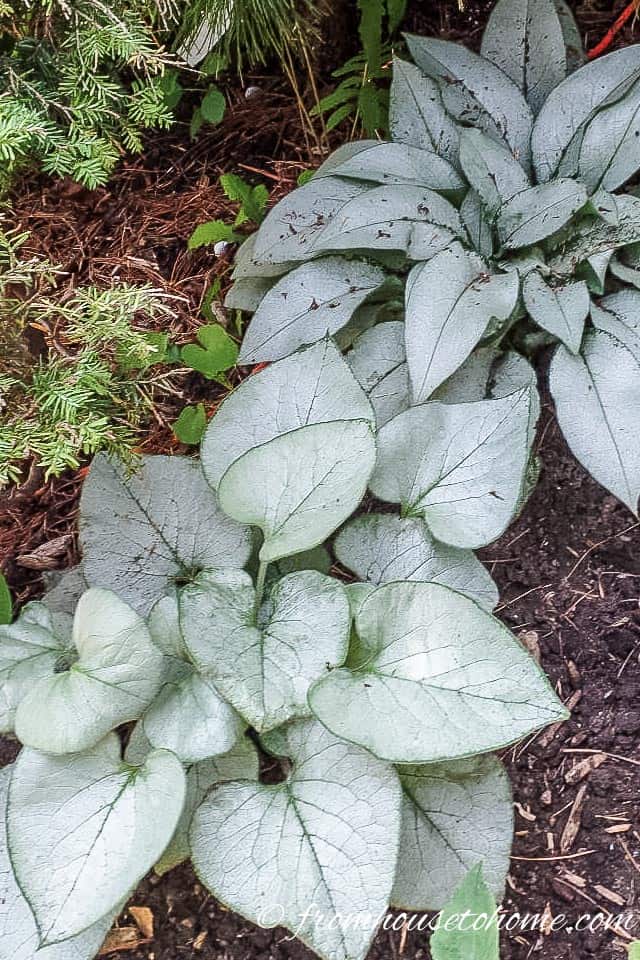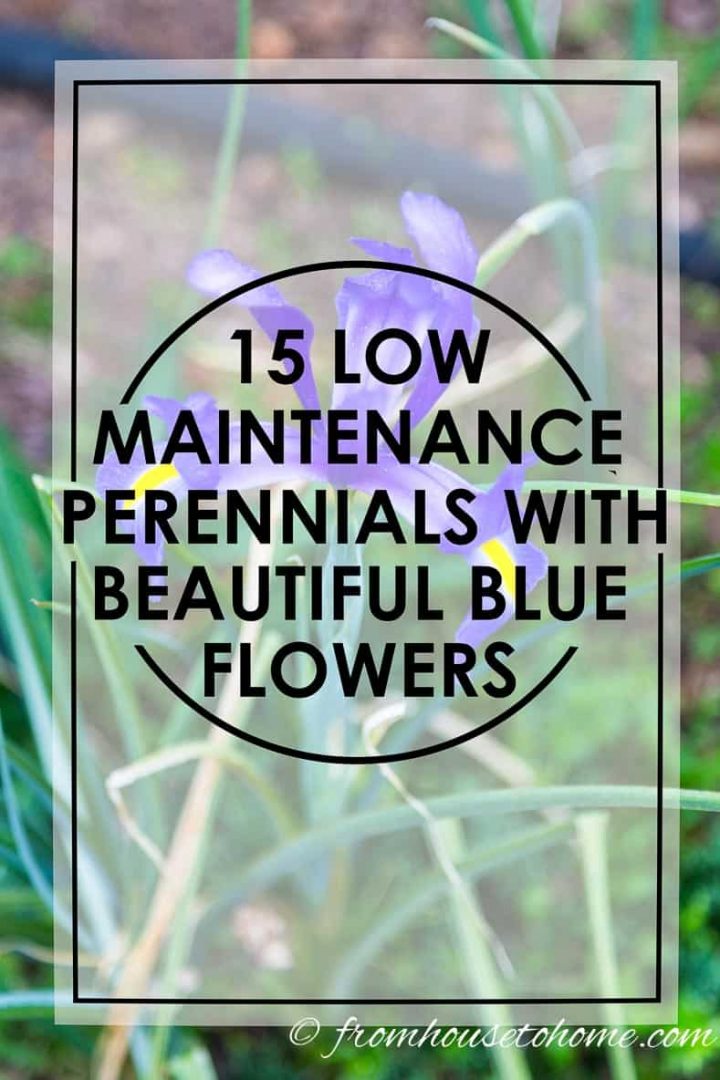Blue Flowering Perennials (15 Easy To Grow Plants)
If you're looking to add a pop of color to your garden, consider adding some blue flowering perennials. Blues are stunning with other colors in the garden or in monochromatic drifts. There are a number of different plants with blue flowers that are also low maintenance, so you're sure to find at least one that's perfect for your garden.

Every year, I get the gardeners “bug”…the desire to buy new plants even though I have no space in the garden to put anything (and not much time to do any planting).
Since I have never been able to talk myself out of buying new plants, the least I can do is get ones that are low maintenance and that I love!
With that in mind (and since blue is my favorite color), I created a list of low maintenance perennials with beautiful blue flowers. And thought I'd share since you might like these, too.
Keep reading to find out what my favorite easy-to-grow blue flowering perennials are.
1 | Globe Thistle (Echinops)

Zone: 3 to 9
Exposure: Full sun
Height: 2′ to 4′
Width: 2′
Bloom time: Summer to fall
Flower color: Bright blue
Globe thistles are a very drought-resistant perennial that produces spherical stunning blue flowers in the mid to late summer.

They provide some color to the late summer garden, attract butterflies and are also great for using in dried flower arrangements…a very versatile plant!
2 | Catmint (Nepeta x faassenii)

Zone: 3 to 9
Exposure: Full sun
Height: 1′ to 2′
Width: 2′ to 3′
Bloom time: Spring to summer
Flower color: Purple blue
Catmint is a perennial herb that produces purple blue blooms above bluish-green leaves and blooms for quite a long time.
As an added bonus, it is drought tolerant and deer resistant…one tough plant!
3 | Dutch Iris

Zone: 3 to 9
Exposure: Part sun to full sun
Height: 20″ to 24″
Width: 6″
Bloom time: Late spring
Flower color: Blue with yellow
These beautiful blue irises have yellow throats which make the blue stand out even more.
They grow from bulbs that you can plant in the fall, and make a beautiful display in the late spring.
The leaves die back after the plant has finished blooming, so it helps to plant them with later-blooming companion plants that will fill in the space.
Also (as with other spring blooming bulbs), don't cut the leaves off until they have turned brown…they are strengthening the bulbs for next year's blooms!
4 | Iris reticulata

Zone: 5 to 8
Exposure: Full sun
Height: 6″ to 8″
Width: 6″ to 8″
Bloom time: Early spring
Flower color: Blue with yellow and white
Iris reticulata is another spring-flowering bulb that is planted in the fall and has blue petals with similar colors to the Dutch Iris above.
This plant is quite short and is one of the first to bloom in early spring. Always a welcome site when winter is finally over!
I like to combine it with Phlox subulata since the Phlox will hide the dying bulb leaves.
5 | Moss or creeping Phlox (Phlox subulata)

Zone: 2 to 9
Exposure: Full sun
Height: 4″ to 6″
Width: 1′ to 4′
Bloom time: Spring
Flower color: Periwinkle blue
Speaking of Phlox subulata, it also makes our list of blue flowering plants.
Creeping phlox is an easy-to-grow perennial that makes a wonderful, periwinkle blue ground cover.
In the spring, it is covered in blooms, and the plant is dense enough to discourage most weeds.

While it spreads out quite a bit, it isn't invasive. You can easily pull it out if it's growing where you don't want it.
Give creeping Phlox a trim in the summer after it has finished blooming to encourage even more blooms the following year.
6 | Salvia

Zone: 8 to 10
Exposure: Full sun
Height: 3′ to 4′
Width: 1′ to 2′
Bloom time: Summer to fall
Flower color: Dark blue
The Salvia plant family has a few blue varieties, but Salvia guaranitica “Black and Blue” is my favorite.
It has a stunning combination of bright blue flowers with black stems.
Like most Salvias, it requires very little work and blooms all summer long.
However, it is a tender perennial that should be treated as an annual in some parts of the country. (It comes back every year in my zone 7 garden in South Carolina.)
7 | Virginia Bluebells (Mertensia virginica)

Zone: 3 to 8
Exposure: Part shade to shade
Height: 2′
Width: 2′
Bloom time: Spring
Flower color: Pale blue
Virginia Bluebells (or Virginia cowslip) are blue flowering plants that are native to North America and require almost no maintenance.
It sends up flower stalks in the spring that start out with pink buds and then open to light blue blooms.

The plants will go dormant in the summer, so be sure to plant it with other later-blooming perennials that will cover the bare spots.
8 | Clematis

Zone: 3 to 8
Exposure: Part shade
Height: 4′ to 10′ (depending on the variety)
Width: 2′
Bloom time: Spring to fall (depending on the variety)
Flower color: Dark blue, light blue, purple-blue
Clematis is a perennial vine that has beautiful flowers, doesn't take much maintenance and usually “plays nicely with others”.
In other words, most varieties can be grown in, on and around other plants without causing issues.

Add there are many varieties with different shades of blue flowers that bloom at different times.
So if you choose wisely, you could have blue blossoms in your garden all season long!
Find out more about growing clematis HERE.
9 | Columbine (Aquilegia)

Zone: 3 to 9
Exposure: Part shade to sun
Height: 1′ to 2′
Width: 1′ to 2′
Bloom time: Spring to early summer
Flower color: Royal blue, purple blue
Columbines are another very easy to grow, native, blue flowering perennial.

While they are not invasive, they do tend to self-seed, and you will often find a couple of new plants growing where you didn't plant them.
But with such pretty flowers and leaves, I usually just let them be.
10 | Forget-Me-Nots (Myosotis)

Zone: 4 to 9
Exposure: Shade
Height: 6″ to 2′
Width: 6″ to 12″
Bloom time: Spring
Flower color: Light blue
Forget-me-nots are another native plant.
It has very pretty star shaped, sky blue flowers in the spring and is very easy to grow.
These plants do tend to self-seed, so they work very well for naturalizing a wooded area.
But in your garden, you may need to spend some time removing the new plants that pop up every year where you weren't expecting them.
11 | Blue Delphiniums

Zone: 3 to 7
Exposure: Full sun to part sun
Height: 1′ to 3′
Width: 1′ to 2′
Bloom time: Summer
Flower color: Deep blue
Delphiniums are a summer-blooming perennial that provides true blue flowers on long flower stalks.
The standard varieties often need staking, so are a little more work than some of the plants on this list.
However, they are such a beautiful blue, I couldn't leave them off!
Delphiniums don't like hot weather so tend to do better in northern climates than in the south.
But I love them so much that in my South Carolina garden, I plant them as annuals in the spring (they always die in the heat of the summer).
12 | Blue false Indigo (Baptisia)

Zone: 3 to 10 (depending on the variety)
Exposure: Full sun to part sun
Height: 3′ to 5′
Width: 2′ to 3′
Bloom time: Summer
Flower color: Indigo blue
False Indigo is another blue flowering perennial that produces tall stocks with indigo blue flowers during the summer.
But it is a native plant and is much more tolerant of heat than Delphiniums.
It is long blooming and long lived, producing more and more flowers each year after it is established.
This plant does get quite big, so make sure to give it lots of room to grow.
13 | Cranesbill (Perennial Geranium)

Zone: 4 to 8
Exposure: Part shade
Height: 12″ to 18″
Width: 12″ to 18″
Bloom time: Summer
Flower color: Violet blue
Perennial geraniums are not to be confused with the annual geranium that usually has pink or red flowers.
These plants are another easy to grow perennial that provide really blue blooms and require very little maintenance.
They form small mounds that flower in the late spring through the summer.
Cutting them back after the first blooms are finished will encourage a second round.
14 | Siberian bugloss (Brunnera macrophylla)

Zone: 3 to 8
Exposure: Part shade to shade
Height: 12″ to 18″
Width: 18″ to 24″
Bloom time: Early spring
Flower color: Light blue
Brunnera macrophylla is a low-growing perennial with large leaves that blooms early in the spring.
It can be planted in the shade and doesn't require much maintenance other than consistent watering.

As a bonus, many of them have very pretty leaves that will look good in your garden even when they are not blooming.
These plants do not do well in hot and humid weather, so are harder to keep alive if you are gardening in the South East.
15 | Lily of the Nile (Agapanthus)

Zone: 6 to 11
Exposure: Sun to part shade
Height: 3′ to 5′
Width: 2′ to 3′
Bloom time: Summer to fall
Flower color: Various shades of blue (depending on the variety)
Lily of the Nile grows from a Rhizome that slowly expands to form a 2 to 3 foot clump, producing many ball-shaped blue flowers.
It can be a little finnicky to get going. But once it is established, it requires very little maintenance.
And will bloom all summer long.
16 | Hydrangea macrophylla

Zone: 3 to 9
Exposure: Part shade
Height: 2′ to 6′ (depending on the variety)
Width: 2′ to 6′
Bloom time: Summer to fall
Flower color: Blue
Hydrangea macrophylla is a large perennial or small shrub that has a lot of blue varieties.
In fact, for many lace-cap hydrangeas (above) and mophead hydrangeas (below), you can actually control how blue the flower is. The more acidic the soil the bluer they will be.
If your flowers are pink or just not blue enough for your liking, add some soil acidifier (like you would normally put on rhododendrons), and watch the bloom colors change.

Note: This trick won't work with white hydrangeas, or the Hydrangea paniculata varieties, so you make sure you have one of the pink or blue Hydrangea macrophylla varieties.
That's it for our low maintenance blue flowering perennials. Hopefully you have found some inspiration to include one or two in your garden!
Other blue flowering plants you might like
- Blue plants for containers in the shade
- Purple and blue perennials for part shade
- Early spring blue flowering plants
Have comments or questions on on our blue flowering perennials? Tell us in the section below.
Pin It So You Don't Forget It!

This post was originally published on May 18, 2016 but was updated with new content on November 23, 2024.






































G’day Wanda,and thank you for this most valuable data on blue flowers because you don’t always see many such colours in a garden,or may be I don’t look hard enough..I will visit my nursery in two weeks(work f/t) and take with me YOUR precious list..God bless you and your family and happy gardening..Ron Lock..Geelong,Victoria,Australia
Thanks for visiting from Australia, Ron! Good luck with your plant shopping 🙂
Wanda, you have certainly overlooked my favorite 2 blue flowers—— blue flax, which blooms 4-6 weeks, giving you fresh flowers daily. I have it down my driveway with thousand of blooms during the month of May & into June. It is a perennial, but it is he only plant that I let seed in my yard, so that it always looks full. The foliage is also beautiful when not in bloom. My other favorite is the balloon flower. The buds swell like a hot air balloon, & then opens the next day. I recently discovered how to divide this plant. In Ohio, it comes up in mid May & that is when you divide. I did it 2 years ago & have had luck. Check them out.
Thanks, Helen! You are right…those two blue flowers do deserve to be on the list 🙂
hey wanda! My garden has a color palette of blue purple and white, with some deepred plants for contrast, like heuchera. My alltime favorites of blue arent on your list! so i thought i would just add them here. number one: Lithodora. stays pretty low, but grows wider each year and really intensly blue flowers! and is green through winter, also a plus. number 2: ceanothus. i have both the shrub variety and the climbing one, a softer blue, more like the echinops. fast growing, looooong blooming and smells lovely. and last but not least: lupine. who doesnt love those?
loved the post, btw. greetings from holland!😁
Thanks for the additions to the list, Francis! I haven’t tried Lithodora or Ceanothus. They sound pretty. I’ll have to look into them. And you’re right, I forgot about Lupines 🙂
You forgot my favorites Veronica and campanula. I think certain kinds of Veronica are “ true blue”. I have ‘Wizard of Ahs’ I believe that’s the spelling. Anyways, it is true blue in my opinion. I love waterfall campanula but it’s more of a bluish/lavender. Also, Asters, I have ‘blue bird’ and it is close to “true blue”. I have three and like them. I have Echinops that you mentioned. I also have a Rose of Sharon and Salvias. I feel the annual salvia is more true blue then the perennials that I have in my garden. I’m gardening in zone 6.
Thanks for the suggestions, Michelle! You’re right, Veronica and Campanula should be on the list 🙂
Whenever I plant blue flowers, they come up purple or pink. This has happened with delphinium, phlox, clematis, salvia, and a number of other “blue” cultivars. Most of these I had purchased from reputable growers, so I don’t think the plants are the problem. Do you have any suggestions for my helping them to bloom true blue? Thank you.
Hi…some types of blue-flowered plants (like hydrangeas and delphiniums) need acidic soil to keep their blue color. So it may be that your soil is too alkaline. Sprinkling some soil acidifier around the plants 3 or 4 times a year should help. This won’t work for all plants, however. (As an example, Clematis prefers more alkaline soil so this fix probably isn’t a good idea for it.) So you should probably look up the plants to see which ones this will work for.
Catmint is a spreader but my cats love it. Rose of. Sharon is a spreader also. I spend hours every summer pulling out new sprouts they make a great fence if you want some privacy or to block some noise
Thanks for the tips, Aileen!